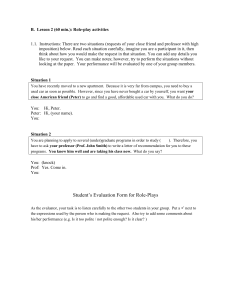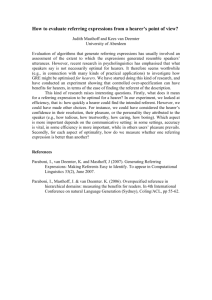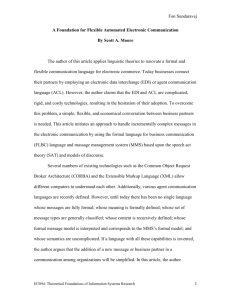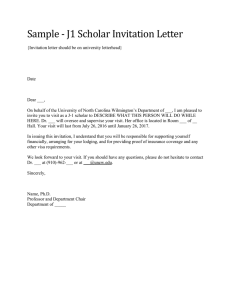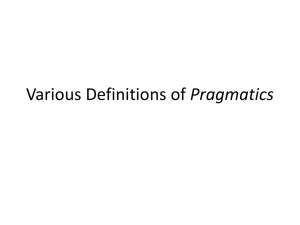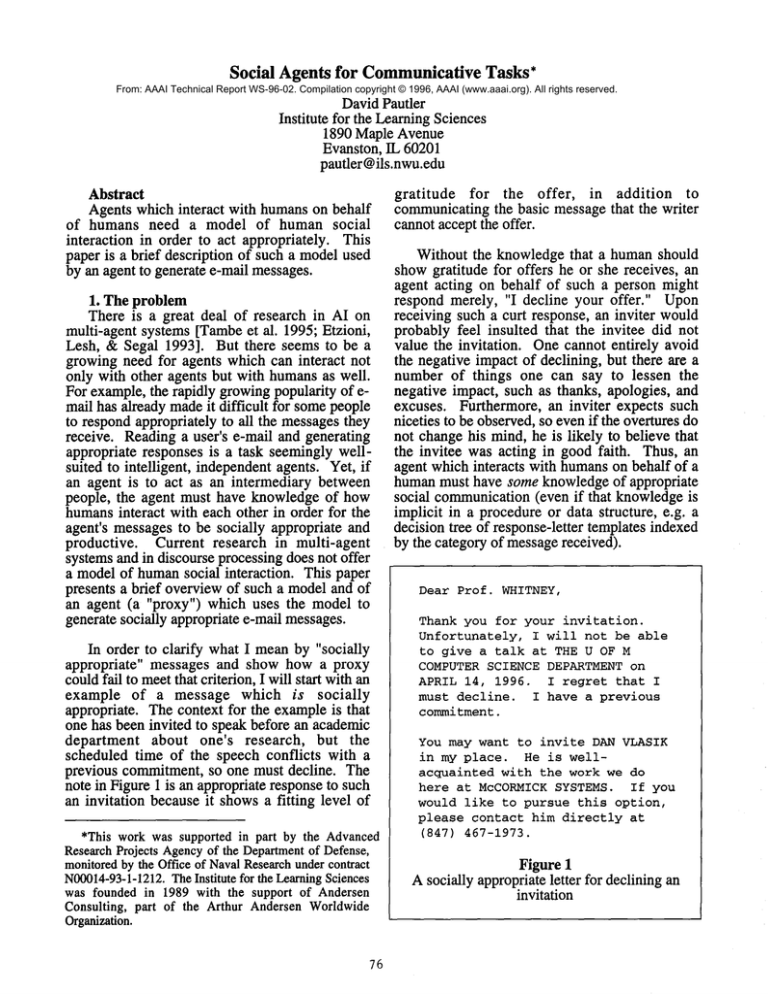
Social
Agents for Communicative Tasks*
From: AAAI Technical Report WS-96-02. Compilation copyright © 1996, AAAI (www.aaai.org). All rights reserved.
David Pautler
Institute for the LearningSciences
1890 Maple Avenue
Evanston, IL 60201
pautler@ils.nwu.edu
Abstract
Agents which interact with humanson behalf
of humans need a model of human social
interaction in order to act appropriately. This
paper is a brief description of such a modelused
by an agent to generate e-mail messages.
1. The problem
There is a great deal of research in AI on
multi-agent systems [Tambeet al. 1995; Etzioni,
Lesh, & Segal 1993]. But there seems to be a
growing need for agents which can interact not
only with other agents but with humansas well.
For example, the rapidly growingpopularity of email has already madeit difficult for somepeople
to respond appropriately to all the messagesthey
receive. Reading a user’s e-mail and generating
appropriate responses is a task seemingly wellsuited to intelligent, independentagents. Yet, if
an agent is to act as an intermediary between
people, the agent must have knowledge of how
humansinteract with each other in order for the
agent’s messages to be socially appropriate and
productive. Current research in multi-agent
systems and in discourse processing does not offer
a model of humansocial interaction. This paper
presents a brief overviewof such a model and of
an agent (a "proxy") which uses the model
generate socially appropriate e-mail messages.
In order to clarify what I meanby "socially
appropriate" messages and show how a proxy
couldfail to meetthat criterion, I will start with an
example of a message which is socially
appropriate. The context for the exampleis that
one has been invited to speak before an academic
department about one’s research, but the
scheduled time of the speech conflicts with a
previous commitment, so one must decline. The
note in Figure 1 is an appropriate response to such
an invitation because it showsa fitting level of
*This work was supported in part by the Advanced
Research Projects Agency of the Department of Defense,
monitored by the Office of Naval Research under contract
N00014-93-1-1212.The Institute for the Learning Sciences
was founded in 1989 with the support of Andersen
Consulting, part of the Arthur Andersen Worldwide
Organization.
76
gratitude
for the offer, in addition to
communicatingthe basic message that the writer
cannot accept the offer.
Without the knowledge that a humanshould
show gratitude for offers he or she receives, an
agent acting on behalf of such a person might
respond merely, "I decline your offer." Upon
receiving such a curt response, an inviter would
probably feel insulted that the invitee did not
value the invitation. One cannot entirely avoid
the negative impact of declining, but there are a
number of things one can say to lessen the
negative impact, such as thanks, apologies, and
excuses. Furthermore, an inviter expects such
niceties to be observed, so evenif the overtures do
not changehis mind, he is likely to believe that
the invitee was acting in good faith. Thus, an
agent which interacts with humanson behalf of a
humanmust have some knowledge of appropriate
social communication(even if that knowledgeis
implicit in a procedure or data structure, e.g. a
decision tree of response-letter templates indexed
by the category of messagereceived).
Dear Prof. WHITNEY,
Thank you for your invitation.
Unfortunately,
I will not be able
to give a talk at THE U OF M
COMPUTER SCIENCE DEPARTMENT on
APRIL 14, 1996. I regret that I
must decline. I have a previous
commitment.
You may want to invite DAN VLASIK
in my place. He is wellacquainted with the work we do
here at McCORMICK SYSTEMS. If you
would like to pursue this option,
please contact him directly at
(847) 467-1973.
Figure 1
A socially appropriate letter for declining an
invitation
2. Planning knowledge
Unless one uses a simple frameworksuch as a
decision tree, generating text to meet a variety of
social constraints
means planning text.
Furthermore, planning in a domain requires a
specification of the acts, act preconditions, and act
effects of the domain. Research on "speech acts"
in the philosophy of language [Austin 1975;
Vanderveken1991 ] and in linguistics [Wierzbicka
1987] is an important resource for such act
specifications
for communication. Work in
discourse processing has borrowed from that
research to build both parsers and generators
[Cohen & Perrault 1979; Moore & Paris 1994].
However, those discourse processing systems
have generally used only speech acts closely
related to Inform and Request acts and not more
socially relevant acts such as Praise, Thank,and
Apologize ([Bruce 1975] is an exception). Also,
the analyses of speech act effects done in
philosophy and linguistics do not extend beyond
the beliefs ("illocutionary" effects) induced
hearers of an act. That is, the analyses do not
include further effects on the emotions,
relationships, or responsibilities of the persons
involved. Clearly, such effects are an important
part of social interactions and should be included
in a model intended to be used by a planning
social agent.
At first glance, the effects resulting from an
induced belief may seem nearly innumerable.
Certainly, the relations betweenthese effects can
be very complicated. But if one enumerates a
small set of "effects of interest" and maps a
limited set of connections, one can establish the
core of a modelwhich can be extended gradually.
Figure 2 illustrates the networkof abstract states
which I used as a guide in developing the model.
In the network,a hearer’s belief in the content of a
speech act often leads to hearer goals, emotions,
beliefs about the personality traits of the speaker,
and beliefs about the hearer’s ownrights and
responsibilities. There are also several causal
relations of interest amongthese later effects, such
as the effect a trait impression may have on
whether one likes another person. Furthermore,
changes to a bearer’s emotions about another
person maycause changes in the hearer’s attitude
toward his relationship with that person. As an
example of a chain of effects which conforms to
this abstract description, consider the effects of
the expression of thanks whichappeared in Figure
1. The usual effect of a Thankact is a belief of
the hearer that the speaker feels gratitude. Sucha
belief maythen lead the hearer to have a goal to
say, "You’re welcome" in response. Also, the
77
belief maygive the impression that the speaker is
conscientious (due to his acknowledgmentof his
social debt). In turn, such an impressionmaylead
the hearer to begin to like the speaker(i.e. to feel
a positive emotiontoward him). If the feeling is
mutual, the two individuals might enter into a
cordial relationship. 1
Thenetwork depicted in Figure 2 is useful for
the analysis of the effects of manyspeech acts.
Figure 3 illustrates several such analyses for acts
which culminate in a positive effect on cordial
relationships. 2 (The model has similar analyses
for acts such as Criticize and Threaten which
have negative or corrective effects on cordial
relationships.)
1The Thank example does not include an effect on the
hearer’s rights or responsibilities. Twoacts which do have
such an effect are Permit and Prohibit.
2Effects on goals and rights have been omitted from Figure
3 in order to reduce graphical complexity. Chains of such
effects are easily imagined for acts such as Request and
Permit.
Practical
effects
Psychological
effects
Social
effects
H’s activities H’s emotionsS’s relationship
(especially
with H
~1~
toward S) ~I~
impression
~.
of
S’straits
Key:
~
Arrows
H’s goaIs..l
~’l’s~H’s rights and
indicate
causal
~~’ responsibilities
with S
relationH’s
beliefs
ships.
\
S’s speechacts to H
Figure 2
A networkof abstract act effects
+/
-+>+
m-"+
...................
o.>.~
¯ "r".m
C3,.
’-r m
CO
~I
=~-+
I II
II
Relation- Emotions
ships
,., ._+ .+so.+
,+~
Traits
Acts
Goals
Rights
78
Beliefs
Figure 3 also illustrates
a pair of act
preconditions (or "appropriateness conditions").
Preconditions are as important to the success of
social acts as to the success of .physical acts. For
example, inappropriate
praise may appear
awkward or even sarcastic to a hearer, which
would thwart any motive the speaker mayhave to
ingratiate himself.
As in many physical domains, social act
effects and act preconditions often meshto form
standard sequences of interaction, such as a
speaker’s praising of a hearer followed by the
hearer’s thanking of the speaker for his praise.
These standard sequences or scripts often create
expectations to which one must be sensitive as a
social participant. For example, a speaker who
praises a hearer but does not receive any thanks in
return is likely to believe that the hearer is
ungrateful. (Failing to show gratitude for an
invitation causesa similar effect, due to the failure
of a similar script expectation.) Avoiding such
perceptions seems to be a motivation for many
social actions.
An interesting feature of the model is its
representation of self-reinforcing
cycles of
interaction. In Figure 3, cordial relationships are
shownto oblige cordial acts, whichlinks the "top"
of the model to the "bottom". Similarly,
unfriendly acts often lead to adversarial
relationships, which mayinduce the participants
to act on opportunities to inconvenience each
other. Themodelrepresents cordial relationships
as mutual liking among participants,
and it
represents adversarial relationships as mutual
dislike. Thus, an agent can escape a cycle by
indicating to others in a relationship that feelings
of like or dislike are not mutual. Indicating that
feelings are not mutual should be as simple as
performing an act from the cycle one wishes to
moveinto. If the other persons in the relationship
reciprocate, a new type of relationship becomes
active and one enters a newcycle of interaction.
This description
appears to reflect human
relationship interactions somewhat
faithfully.
The model is currently limited to two-person
interactions. In the future, I intend to include
inherently three-party interactions such as
defaming someoneand showing favoritism.
3. The application
The model of social
acts,
effects,
preconditions, and scripts described above has
been applied to e-mail generation via the
LetterGen agent. LetterGen allows its user to
79
specify a high-level communicative goal (e.g.
decline an invitation politely) and the agent uses
its planning knowledgeto suggest speech acts for
an e-mail messagewhich are appropriate for the
given goal. If the user approves of a suggested
act, LetterGen may then query him or her for
background information to be used in the
instantiation of a sentence text template associated
with the speechact.
The note in Figure 1 was generated by
LetterGen. 3 In response to an input goal to
decline politely, the agent suggests seven acts:
Thank, Decline, Apologize, Make-excuse,
Advise,
Reassure,
and Request.
An
organizational template is used to place these acts
in the e-mail messagein the order given above.
Unlike traditional planners, LetterGen does
not generate all of its suggestions in a means-end
manner. Onlythe Decline act is generated in that
way. The Thank, Apologize, and Make-excuse
acts are suggested in response to the agent’s fear
that the Decline act endangersthe user’s goal to
have the addressee like him or her. (This danger
would comefrom the failure of the addressee’s
expectation that the user be grateful and polite.)
TheReassure act is planned in a similar way, as a
reaction to a "fear" that the addressee maybe
skeptical about the user’s advice. TheAdvise act
is an expression of the user’s personality trait of
helpfulness. This expression of helpfulness is
triggered when the agent notices that the
addressee needs someoneto replace the user in
giving a speech. LetterGen has four general plan
types:
1. Goal pursuit (means-endanalysis).
2. Cost avoidance, i.e. avoidance of
undesired aspects of a current or incipient
situation,
such as unwanted social
perceptions of oneself.
3. Status-quo maintenance,i.e. selection of
an act because one of its effects would
reinforce a desired aspect of the current
situation. For example,one might offer to
help another person because it would
reinforce one’s self-image as a generous
person.
3Thetext in upper-case
is text givenbythe userin response
to a query;text in lower-case
is eithertemplatetext or text
fromrules for selectingpronouns,honorifics,and so on
fromotherinformation
providedbythe user.
4. Trait-based habit, i.e. the performance
of an act as a timeworn expression of a
personalitytrait.
The last three plan types
opportunistically.
6. Console
7. Thank
8. Apologize
9. Acceptan invitation
10. Decline an invitation
11. Encourage someoneto do something
12. Discourage someonefrom something
are triggered
Each plan type is represented as a rule, not a
procedure, and the antecedents of the rules bind to
representations of the current situation, the user’s
social goal, act effects, act preconditions, and
other background knowledge. The consequent of
these rules is a goal to performa specific act.
Onebenefit of representing the types as rules
is that it allows the types to be used to anticipate
the plans of others. For example, the strategy of
enticing someoneto grant a favor by offering
them something could be said to involve two
nested plan types: the other person’s standard plan
to return favors, and one’s ownplan to exploit his
plan by offering him somethingin order to get a
favor in return.
If one attempts to use LetterGen’s plan types
to understand whya particular speech act was
included in a letter, one finds that often morethan
one plan type could have been involved. For
example, the Thankact might have been included
in the exampleof Figure 1 in order to lessen the
social debt the invitee owesto the inviter, or to
avoid insulting the inviter through curtness, or to
makethe invitee feel that he is a polite person, or
simply out of habit. LetterGen’s modelallows for
all of these different plans, but in practice only
one plan is used to generate an act suggestion.
LetterGen is entirely rule-based. Scripts of
standard act plans are encodedas chains of rules
rather than as special data structures. Forty
different speech acts are defined in the agent;
manyof these acts have more than one sentence
template associated with them, to reflect the
different types of content communicatedby the
acts (e.g. expressing a desire to get together to
celebrate versus expressing a desire to be hired).
There are approximately
three hundred
generalized states in its social model.Theagent is
able to generate a dozen messagetypes, each with
manyvariations due to the user’s ability to accept
or reject act suggestions:
1. Initiate a friendship
2. Applyfor a job
3. Terminate a friendship
4. Resign from a job
5. Congratulate
LetterGenmakesat least three act suggestions for
each of these options. For example, the thanking
option leads to a suggestion not just for Thank
but also for Credit and Offer (to repay).
The greatest limitation of the agent is the
genericness of its sentence templates, although
this must be weighedagainst the goal to prevent
the agent from becoming too dependent on the
user for background information. If the agent
requires too muchinput, it loses its appeal as a
work-savingdevice. (Notice that this genericness
is not a problem which could be solved by
replacing the templates with a low-level
generator.)
4. A second example
In order to provide a glimpseof the variety of
states represented in the model, and to illustrate
further some of the limitations in LetterGen’s
generation ability, this section presents an
example of a message aimed at terminating a
friendship.
Because cordial relationships require mutual
feelings of liking, the simplest wayof terminating
such a relationship is for one to indicate one’s
dislike of the other person. A less direct method
is to induce the other person to dislike oneself.
This effect can be induced in a numberof ways,
such as makingoneself appear to have bad traits
(e.g. intrusiveness) and giving the impressionthat
one does not respect the other person.
Given the goal of terminating a friendship,
LetterGen uses the Goal-pursuit plan type to
suggest an Express-anger act, because it would
give an impressionthat the writer is irascible and
thereby cause the addressee to dislike him.
Similarly, LetterGen suggests Denigrate (i.e.
mentiona bad trait of the hearer) becauseit gives
an impression of pettiness, and Prohibit because
it gives an impression of burdensomeness. Blame
is suggested because it gives an impression of
one’s disrespect for the other person.
The four acts mentioned above are not
"focussed"on a particular situation as the acts in
the previous example were for the invitation.
8o
communicative (MTRANS)
acts as both triggers
and responses to themes.
I am very annoyed at YOUR
BEHAVIOR AT MY PARTY THE OTHER
NIGHT. THE POLICE BUST
wouldn’t have happened if it
hadn’t been for your LOUD CAR
STEREO. You are so IMMATURE.
You are not to COME TO ANY MORE
OF MY PARTIES.
Figure 4
Aletter aimedat terminating
a friendship
That is, at this point in the interaction, LetterGen
does not knowwhat to express anger about, what
trait to denigrate, and so forth. Therefore,
LetterGen is muchmoredependent in this case on
the user to provide focussedcontent for the acts in
the form of input text. Figure 4 illustrates an email message generated from the four acts
suggested plus focussed text (which LetterGen
queried the user for in response to the user’s
approval of each suggestion).
If LetterGen could parse the user’s incoming
e-mail, it would be somewhatless dependent on
him for background information. (The social
model was designed not to be biased toward
generation or parsing, with future application to
parsing in mind.) But the improvement would
probably not be dramatic, because muchof the
user’s outgoing messageswouldconcern his faceto-face interactions with others, as wasthe case in
the second example. LetterGen should also have
a memoryso it can develop profiles of the user
and the people he interacts with most often,
because those profiles could be used to mimicthe
user. Furthermore, the social model should have
moredetail so that LetterGencan target its advice
about excuses, offers,
and so forth more
accurately.
5. Related work
Animportant influence on LetterGen’s social
model is the work of Schank and Abelson on
interpersonal themes. Themes are rules which
spawngoals whentriggered by certain situations.
For example, "when we hear that ’John loves
Mary’we can predict howJohn will act if Maryis
threatened, if she is sick, if she is happy, if
another manshowsinterest in her, and so on. All
this information is part of the ’love’ theme."
[Schank & Abelson 1977, p. 139]. Schank and
Abelson
also emphasize
the role of
Tworelated social agent systems are the
Affective Reasoner (AR) [Elliott 1992] and the
Oz Project [Reilly & Bates 1992]. AR’s agents
are customers and taxi drivers in a simulated
TaxiWorld. The agents construe events and react
to them in the emotion-laden manner one would
expect in such a domain. The Oz Project is
similar to ARin its emphasis on believably
emotional agents (who create dramatic situations
for the enjoyment of the user through their
interactions with each other). In both systems, the
agents not only modelemotional reactions to their
ownsurroundings but also reason about the likely
emotional reactions of other agents.’ The agents
represent beliefs, goals, and relationships as these
relate to emotions. Yet, the agents interact only
with other simulated agents, not with humansand
not on behalf of humans. Such an approach has
the practical benefit (but potential cost to
verisimilitude) of avoiding the great variety of
humaninteraction patterns one finds in speech
acts and other forms of pragmatic communication.
6. Futuredirections
LetterGen’s social model is applicable to
several tasks other than text generation. Because
the modelis represented in terms of causal chains,
it can be used to:
1.
2.
3.
likely
4.
due to
Predict the reactions of others
Plan based on expected reactions
Interpret the acts of others in termsof their
motives
Diagnoseerrors in plans, particularly errors
overlookedeffects of an act
Thesefunctionalities are not limited solely to
verbal acts, either. Physical acts such as helping,
impeding, and tolerating all have an immediate
effect on an observer’s beliefs whichis similar to
the effect of speech acts on belief (because these
physical acts also communicate).Because of this
shared starting point, all of the states of the model
whichfollow from belief can be used for physical,
communicativeinteractions as well.
The openness of the model to different tasks
and domains is part of LetterGen’s design. One
thing that it seems all future proxy agents will
need is an understanding of humaninteraction.
As LetterGen’s social model is expanded and
4The models of emotion used in both systems are based on
the theory presented in Ortony, Clore, and Collins 1988.
81
improved, it has the potential to become a
resource for work on proxy agents for other
applications.
Acknowledgments
I amgrateful to RogerSchankfor his guidance
and support. I would also like to thank Andrew
Ortonyfor his helpful criticism of this project.
References
Austin, J.L. 1962. Howto do things with words.
eds., J. Urmson and M. Sbis~. Harvard
University Press.
Bruce, B. 1975. Belief systems and language
understanding. Technical Report 2973. Bolt,
Beranek, and Newman.
Elliott, C. 1992. The Affective Reasoner: A
process model of emotions in a multi-agent
system. Technical Report 32, Institute for the
Learning Sciences, Northwestern University.
Etzioni, O., N. Lesh, and R. Segal. 1993. Building
softbots for UNIX(preliminary report).
Technical Report 93-09-01, University of
Washington.
Moore, J.D. and C.L. Paris. 1994. Planning Text
for Advisory Dialogues: Capturing Intentional
and Rhetorical Information. Computational
Linguistics (19) 4. 651-694.
Ortony, A., G. Clore, and A. Collins. 1988. The
Cognitive Structure of Emotions. NewYork:
CambridgeUniversity Press.
Perrault, C.R. and J. Allen. 1980. A plan-based
analysis of indirect speech acts. American
Journal of Computational Linguistics (6) 3-4.
167-182.
Reilly, W. and J. Bates. 1992. Building Emotional
Agents. Technical Report 143, Computer
Science Department,
Carnegie Mellon
University.
Schank, R. and R. Abelson. 1977. Scripts, Plans,
Goals, and Understanding: An inquiry into
HumanKnowledgeStructures. Hillsdale, N J:
Lawrence Erlbaum Associates.
Tambe, M., W. Johnson, R. Jones, F. Koss, J.
Laird, P. Rosenbloom, and K. Schwamb.1995.
Intelligent Agents for Interactive Simulation
Environments. AIMagazine16 (1). 15-39.
Vanderveken, D. 1991. Meaningand speech acts.
Volume 1. NewYork: Cambridge University
Press.
Wierzbicka, A. 1987. English speech act verbs.
Sydney: AcademicPress.
82

